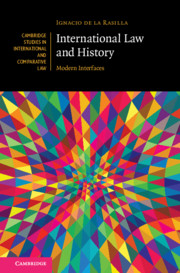Book contents
- International Law and History
- Cambridge Studies in International and Comparative Law: 152
- International Law and History
- Copyright page
- Dedication
- Epigraph
- Contents
- Acknowledgements
- Introduction
- 1 The Turn to the History of International Law
- 2 Contextual Approaches to the History of International Law
- 3 Critical/Postmodern Approaches to the History of International Law
- 4 TWAIL/Post-colonial Approaches to the History of International Law
- 5 Global Approaches to the History of International Law
- 6 Feminist Approaches to the History of International Law
- 7 Normative Approaches to the History of International Law
- 8 Sociological Approaches to the History of International Law
- 9 Institutional Approaches to the History of International Law
- 10 Biographical Approaches to the History of International Law
- 11 Multi-perspectivity and Periodization in the History of International Law
- Bibliography
- Index
- Cambridge Studies in International and Comparative Law
9 - Institutional Approaches to the History of International Law
Published online by Cambridge University Press: 07 January 2021
- International Law and History
- Cambridge Studies in International and Comparative Law: 152
- International Law and History
- Copyright page
- Dedication
- Epigraph
- Contents
- Acknowledgements
- Introduction
- 1 The Turn to the History of International Law
- 2 Contextual Approaches to the History of International Law
- 3 Critical/Postmodern Approaches to the History of International Law
- 4 TWAIL/Post-colonial Approaches to the History of International Law
- 5 Global Approaches to the History of International Law
- 6 Feminist Approaches to the History of International Law
- 7 Normative Approaches to the History of International Law
- 8 Sociological Approaches to the History of International Law
- 9 Institutional Approaches to the History of International Law
- 10 Biographical Approaches to the History of International Law
- 11 Multi-perspectivity and Periodization in the History of International Law
- Bibliography
- Index
- Cambridge Studies in International and Comparative Law
Summary
Whether it is in terms of standard-setting, international law-making, international adjudication, or international enforcement of international norms, global, regional, and operationally conceived international institutions and organizations have become fundamental actors in the great contemporary world theatre where the drama of international law is constantly being re-staged. International institutions and organizations (IOs) are ‘frequently, if not exclusively’ terminologically equated with ‘intergovernmental organizations’, which are defined as ‘organization[s] established by a treaty or other instrument governed by international law and possessing [their] own international legal personality’ that ‘may include as members, in addition to states, other entities’. Although IOs have had a number of both practical and intellectual historical forerunners since the Central Commission for Navigation on the Rhine, which is usually considered the first IO, was set up in 1815, the reach of IOs has expanded exponentially through multiple functional international areas to reach an estimated number of over 350 worldwide today.
- Type
- Chapter
- Information
- International Law and HistoryModern Interfaces, pp. 283 - 307Publisher: Cambridge University PressPrint publication year: 2021



